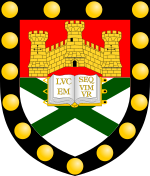Cowley, Devon

Cowley is a hamlet in the parish of Upton Pyne in Devon, England. Cowley church was built as a chapel of ease to Brampford Speke by Rohde Hawkins in 1867–8.It is chiefly notable for a fine three-arched bridge of classical design, built over the River Creedy in 1813-14 by James Green, pupil of John Rennie and surveyor to the county of Devon. Although so recent in date, the bridge has been scheduled as an ancient monument. Cowley Bridge Junction is a railway junction on the former Bristol and Exeter Railway, that allows access to the former North Devon Railway towards Barnstaple, now renamed the Tarka Line. In 1848, the Exeter and Crediton Railway had built a station at Cowley Bridge, but it never opened.
Excerpt from the Wikipedia article Cowley, Devon (License: CC BY-SA 3.0, Authors, Images).Cowley, Devon
St Andrew's Road, Exeter Upton Pyne
Geographical coordinates (GPS) Address Nearby Places Show on map
Geographical coordinates (GPS)
| Latitude | Longitude |
|---|---|
| N 50.750833333333 ° | E -3.5525 ° |
Address
St Andrew's Road
EX5 5EL Exeter, Upton Pyne
England, United Kingdom
Open on Google Maps










